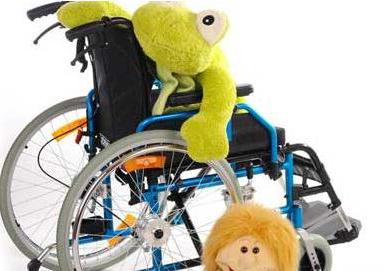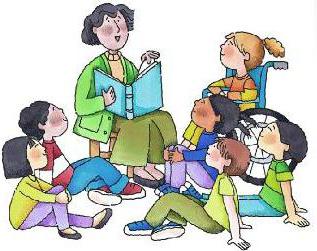In recent years, considerable attention has been paid to the problems of children with special health capabilities (HIA). What is it and how to solve them? Let's try to figure it out.
Disabled Health (HIA). What it is?
Scientific sources of literature describe that a person with disabilities has certain limitations in everyday life. We are talking about physical, mental or sensory defects. A person therefore cannot perform certain functions or duties.

This condition is chronic or temporary, partial or general.
Naturally, physical limitations impose a significant imprint on psychology. Typically, people with disabilities tend to isolation, are characterized by low self-esteem, increased anxiety and self-doubt.
Therefore, work must begin with childhood. Significant attention in the framework of inclusive education should be given to the social adaptation of persons with disabilities.
Three-level Disability Scale
This is her British version. The scale was adopted in the eighties of the last century by the World Health Organization. It includes the following steps.
The first is called "ailment." This is any loss or anomaly (psychological / physiological, anatomical structure or function).
The second stage involves patients with defects and loss of ability to perform activities that are considered normal for other people.
The third stage is incapacity (disability).
Types of OVZ
In the approved classification of violations of the basic functions of the body, a number of types are identified. Let us dwell on them in more detail.
1. Disorders of mental processes. It is about perception, attention, memory, thinking, speech, emotions and will.
2. Disorders in sensory functions. It is sight, hearing, smell and touch.
3. Violations of the functions of respiration, excretion, metabolism, blood circulation, digestion and internal secretion.
4. Changes in the statodynamic function.

Children with disabilities that belong to the first, second and fourth categories, this is most of the total. They are distinguished by certain deviations and developmental disorders. Therefore, these children require special, specific methods of training and education.
Psychological and pedagogical classification of children who belong to the special education system
Let's consider this question in more detail. Since the choice of techniques and methods of training and education will depend on this.
- Children with developmental disorders. They lag behind in mental and physical development due to the fact that there is an organic lesion of the central nervous system and impaired functioning of the analyzers (auditory, visual, motor, speech).
- Children who have developmental disabilities. Differ in the above deviations. But they limit their capabilities to a lesser extent.
Children with disabilities, children with disabilities have significant developmental disabilities. They enjoy social benefits and benefits.
There is also a pedagogical classification of violations.
It consists of the following categories.
Children with disabilities:
- hearing (late deaf, hard of hearing, deaf);
- vision (visually impaired, blind);
- speech (varying degrees);
intelligence; - delayed psycho-speech development (ZPR);
- musculoskeletal system;
- emotional and volitional sphere.
A separate category is children with multiple disorders (a combination of two or three disorders).
Four degrees of health problems
Depending on the degree of impairment of functions and adaptation possibilities, the degree of impairment of health can be determined.
Four degrees are traditionally distinguished.
First degree. The development of a child with disabilities occurs against a background of mild to moderate dysfunction. These pathologies may be an indication for recognition of disability. However, as a rule, this does not always happen. Moreover, with proper training and education, the child can fully restore all functions.
Second degree. This is the third group of disabilities in adults. The child has severe disturbances in the functions of systems and organs. Despite treatment, they continue to limit his social adaptation. Therefore, such children need special conditions of study and life.
The third degree of impaired health. It corresponds to the second group of disabilities in an adult. There is a greater severity of violations that significantly limit the ability of the child in his life.
The fourth degree of impaired health. It includes pronounced violations of the functions of systems and organs, due to which there is a social maladaptation of the child. In addition, we can state the irreversible nature of the lesions and, often, the ineffectiveness of measures (medical and rehabilitation). This is the first group of disabilities in an adult. The efforts of educators and doctors are usually aimed at preventing a critical condition.
Problems of development of children with disabilities
This is a special category. Children with disabilities are characterized by the presence of physical and mental disorders that contribute to the formation of disorders of general development. This is a common position. But you need to understand this issue in more detail.
If we talk about a child with minor disabilities, what we have already determined, then it should be noted that when creating favorable conditions, most of the development problems can be avoided. Many violations do not constrain the child and the environment. Competent psychological and pedagogical support of children with disabilities will allow them to master the program material and study together with everyone in a comprehensive school, attend a regular kindergarten. They are free to communicate with their peers.

However, children with disabilities with serious disabilities need special conditions, special education, training and treatment.
Social policy of the state in the field of inclusive education
In Russia, in recent years, certain areas of social policy have been developed that are associated with an increase in the number of children with disabilities. What is it and what problems are solved, we will consider a little later. In the meantime, we note the following.
Basic social provisions politicians rely on modern scientific approaches, available material and technical means, a detailed legal mechanism, national and public programs, a high level of professional training of specialists, etc.
Despite the efforts made and the progressive development of medicine, the number of children with disabilities is growing steadily. Therefore, the main directions of social policy are aimed at solving the problems of their education at school and stay in a preschool institution. Consider this in more detail.
Inclusive education
Education for children with disabilities should be aimed at creating favorable conditions for the realization of equal opportunities with peers, education and a decent life in modern society.

However, the implementation of these tasks should be carried out at all levels, from kindergarten to school. Let us dwell on these stages.
Creating a “barrier-free” educational environment
The basic problem of inclusive education is to create a “barrier-free” educational environment. The basic rule is its accessibility for children with disabilities, the solution of problems and difficulties of socialization.
AT educational institutions which provide their support, it is necessary to comply with general educational requirements for technical equipment and equipment. This is especially true for the implementation of domestic needs, the formation of competence and social activity.
In addition, special attention should be paid to the education and training of such children.
Problems and difficulties of inclusive education
Despite the ongoing work, it is not so simple in the training and education of children with disabilities. Existing problems and difficulties of inclusive education are reduced to the following positions.
Firstly, the collective of children does not always accept a child with disabilities as “their own”.
Secondly, teachers cannot master the ideology of inclusive education, and there are difficulties in implementing teaching methods.
Thirdly, many parents do not want their normally developing children to go to the same class with a “special” child.
Fourth, not all people with disabilities are able to adapt to the conditions of ordinary life, without requiring additional attention and conditions.
Children with disabilities in a preschool
Children with disabilities in preschool are one of the main problems of a non-specialized kindergarten. Since the process of mutual adaptation is very difficult for the child, parents and teachers.

The priority goal of the integrated group is the socialization of children with disabilities. For them, the preschool institution becomes the initial stage. Children with different opportunities and developmental disabilities should learn to interact and communicate in the same group, to develop their potential (intellectual and personal). This becomes equally important for all children, as it will allow each of them to push the existing boundaries of the world around them as much as possible.
Children with disabilities at school
The priority task of modern inclusive education is to increase attention to the socialization of children with disabilities. An approved adapted program is needed for children with disabilities to study in a comprehensive school. However, the currently available materials are fragmented and not integrated into the system.
On the one hand, inclusive education in a comprehensive school begins to appear, on the other hand, the heterogeneity of the composition of students increases, taking into account the level of their speech, mental and mental development.
Such an approach leads to the fact that the adaptation of both conditionally healthy children and children with disabilities is significantly more difficult. This leads to additional, often insurmountable difficulties in the implementation of the individual approach of the teacher.

Therefore, children with disabilities in school cannot simply study on an equal basis with others. For a favorable result, certain conditions must be created.
The main directions of work in the system of inclusive education
For the full development of a child with disabilities in school, it is necessary to work in the following areas.
Firstly, in order to solve problems, it is recommended to create a group of psychological and pedagogical support in an educational institution. Her activities will be as follows: to study the developmental features of children with disabilities and their special needs, to compose individual educational programs, to develop forms of support. These provisions should be recorded in a special document. This is an individual map of psychological and pedagogical support for the development of a child with disabilities.
Secondly, constant adjustment of methods and methods of training and education is necessary.

Thirdly, the support team should initiate a review of the curriculum, taking into account the assessment of the condition of the child and the dynamics of its development. As a result, an adapted version is created for children with disabilities.
Fourth, it is necessary to regularly conduct correctional and developmental classes aimed at increasing motivation, the development of cognitive activity, memory and thinking, and the knowledge of one's personal characteristics.
Fifth, one of the necessary forms of work is working with the family of a disabled child.Its main purpose is to organize assistance to parents in the process of mastering the practical knowledge and skills necessary for the education and training of children with disabilities. In addition, it is recommended:
- actively involve the family in the work of the educational institution, providing psychological and pedagogical support;
- provide counseling to parents;
- to educate the family in accessible methods and methods of assistance;
- organize feedback of parents with an educational institution, etc.
In general, it should be noted that inclusive education in Russia is only beginning to develop.

Professionals leave the profession and they are no longer young, and young people will not go to the ashes. There is no continuity of generations. And most importantly, those for whom all this is done suffer- Children. They cannot wait, they need daily help.